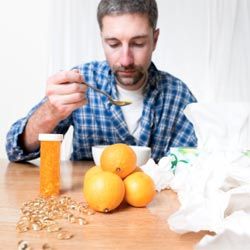Cold and flu symptoms are never the same twice, and that can make it hard to defend against the common cold. One year you have a stuffy head cold; the next you're coughing your head off because a virus is infecting different parts of your respiratory system. Figuring out your cold and flu treatment can be very challenging - especially when you're not sure if your symptoms are for a simple cold or the flu.
In an effort to make your cold treatment choice a little easier, below is a list of common symptoms and doctor-recommended treatments for each. Remember: always consult your physician when taking over-the-counter medications or herbal remedies to ensure your safety and good health.
Advertisement
Your Symptoms Up Close
Cough
Basically there are two kinds of coughs: productive and non-productive. A productive cough is one that allows the mucus accumulated in your air passages, to come forth. This mucus or phlegm is produced as white blood cells and attempt to rid you of infection.
The quicker you get the mucus out or your system, the quicker you'll be feeling better. If you need help getting rid of the excess mucus, an expectorant may be in order. Expectorants help loosen secretions and mucus in the airway, thus making it easier for you to cough the mucus out.
A non-productive cough is dry and is usually caused by mucus dripping from your nasal passages to your throat. This type of cough can be treated with what are known as suppressants. Cough suppressants block your cough reflex so that you don't cough as much when your throat is irritated. Most cough suppressants block the cough reflex in the part of the brain that regulates automatic cough. You may also find relief in sucking on a cough drop or lozenge. The objective is to lull the brain's cough center to be less responsive to signals of irritation.
Advertisement
